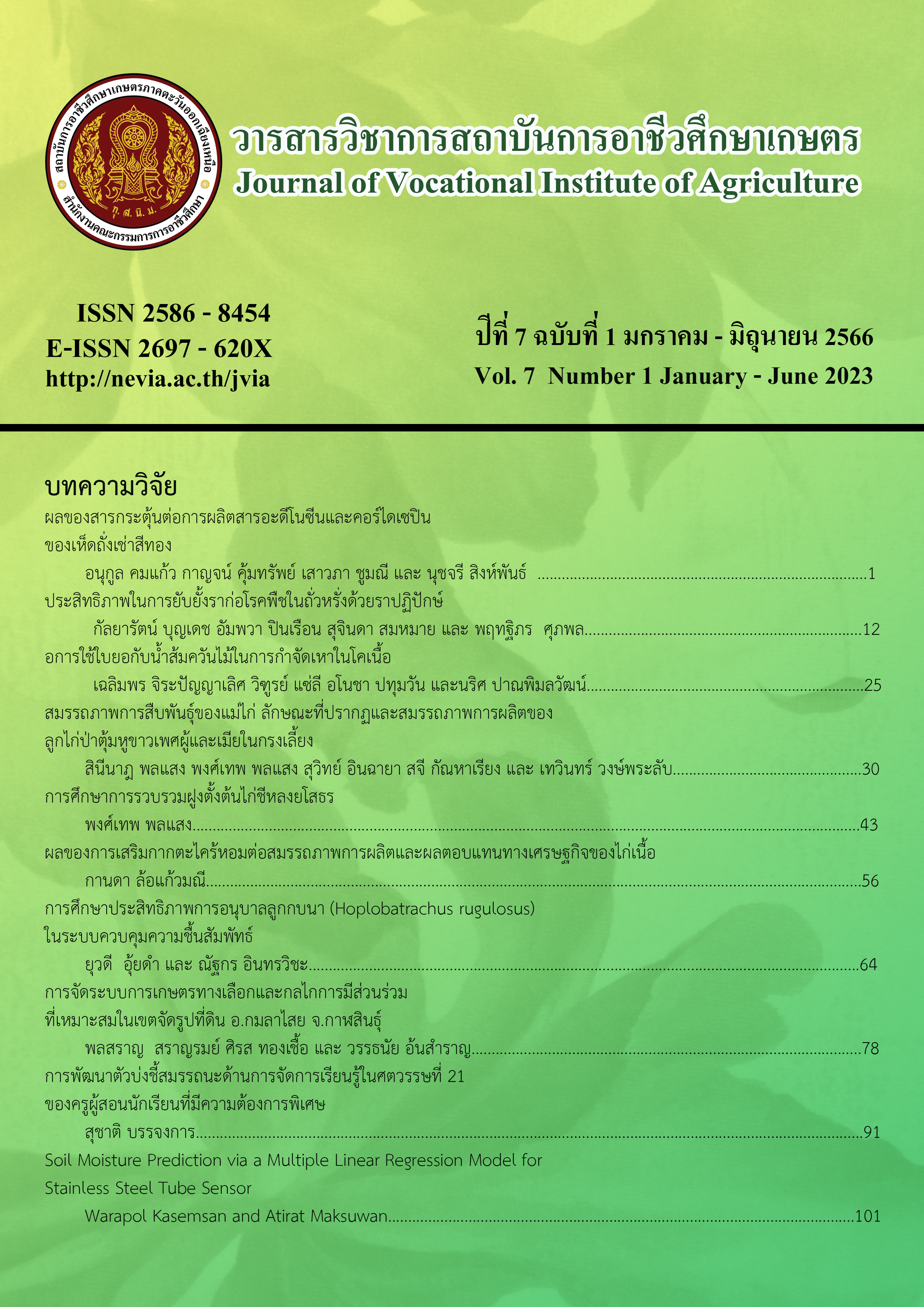Effect of Morindacitrifolia (Noni) Leaves and Wood Vinegar on Controlling Louse of Beef Cattle
Main Article Content
Abstract
This research aimed to investigate effects of using leaves of Noni or Indian mulberry (Morinda citrifolia L) with wood vinegar to eliminate lice in beef cattle. This research was conducted using a Completely Randomize Design CRD) with 4 treatments and 5 replications. There were four treatments, T1 : used 50 grams of indian mulberry leaves with 50 ml of water, T2 : used 50 grams of indian mulberry leaves with 50 ml of wood vinegar, T3 : used 50 grams of indian mulberry leaves with 100 ml of wood vinegar and T4 : used 50 ml of wood vinegar. Four hundred lice with an average body length of 1-2.5 millimeters were used in this experiment. The solutions were sprayed directly on the lice. The results showed that in the T3, lice had the highest mortality rate at 62 percent. The mortality rates of T1, T2 and T4 were 40, 32 and 11 percent, respectively. As for the duration of lice mortality, the lice in T3 began to die after spraying the solution from 10 to 20 minutes and had a high mortality rate from 51 to 80 minutes after spraying. Therefore, 50 g of indian mulberry leaves with 100 ml of wood vinegar was the best ratio of the solution to use for lice elimination
Keywords: lice; indian mulberry leaves; wood vinegar
Article Details

This work is licensed under a Creative Commons Attribution-NonCommercial-NoDerivatives 4.0 International License.
The content and information in articles published in the Journal of Vocational Education in Agriculture are the opinions and responsibility of the article's author. The journal editors do not need to agree or share any responsibility.
Articles, information, content, etc. that are published in the Journal of Vocational Education in Agriculture are copyrighted by the Journal of Vocational Education in Agriculture. If any person or organization wishes to publish all or any part of it or to do anything. Only prior written permission from the Journal of Vocational Education in Agriculture is required.
References
Hengsawat, D. (2011). International characteristics of Thai herbal medicine. Bangkok: Institute for Food Research and Development, Kasetsart University. (in Thai)
Thara, O. (2017). Wood vinegar. Bangkok: Faculty of Forestry, Kasetsart University. (in Thai)
Pongwichai, S. (2015). Statistical data analysis by computer. 25th ed. Bangkok: Chulalongkorn University Press. (in Thai)
Inthaphalan, K., et al. (2022). Efficacy and Safety of Indian Mulberry Leaf Mixed with Galanga Extract Shampoo versus Benzyl Benzoate Lotion for the Treatment of Head Lice Infestation. Thai Pharmaceutical and Health Science Journal. 17(1), 9-14. (in Thai)
Chungsamarnyart, N., et al. (2007). In vitro Study of antiviral activity of plant crude-extracts against the foot and mouth disease virus. Kasetsart Journal (Natural Science), 41, 97-103.
Nuolaong, J. & Poeitae, A. (2010). Eradication of Ectoparasite in the Goat using Wood Vinegar (Research reports). Yala: Yala Rajabhat University. (in Thai)
Eusawat, A., et al. (2000). Formulation of lice-killer herbal shampoos: extract from Annona squamosal Linn, Morinda citrifolia Linn and Cymbopogon nardus (Linn) Rendle. Nakhon Pathom: Faculty of Pharmacy, Silpakorn University. (in Thai)

